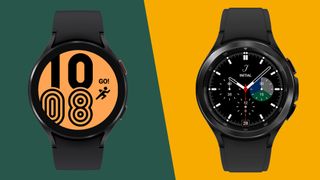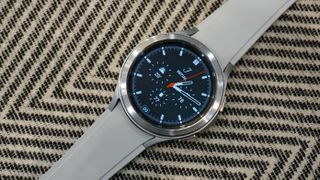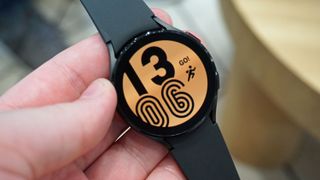Samsung Galaxy Watch 4 vs Galaxy Watch 4 Classic: which new smartwatch is for you?
Sport vs style

The Samsung Galaxy Watch 4 and Samsung Galaxy Watch 4 Classic are arguably the two most exciting smartwatches to have been launched in years – especially for anyone who doesn’t want an Apple Watch.
With a new chipset, a new operating system and new health features there’s a lot here that’s, well, new, but the two wearables also have most of the same key features as each other.
So how do you choose between them? That’s where this article comes in. We’ve compared the Samsung Galaxy Watch 4 and Galaxy Watch 4 Classic in full, so you can see exactly what’s the same and what isn’t.
Design
The Samsung Galaxy Watch 4 and Galaxy Watch 4 Classic have a lot in common, but one thing they don’t share is a design.
The standard Galaxy Watch 4 is a slim, compact smartwatch, coming in at 40.4 x 39.3 x 9.8mm and 26g (without the strap) if you pick the 40mm model, and 44.4 x 43.3 x 9.8mm and 30g (without the strap) if you opt for the 44mm version.
Either way you’re getting a wearable with an aluminum body, slim bezels, and a choice of black, green, silver or pink gold colors for the body – though not all colors are available in both sizes.

The Samsung Galaxy Watch 4 Classic meanwhile is significantly bigger, coming in at 41.5 x 41.5 x 11.2mm and 47g (excluding the strap) if you pick the 42mm model, or 45.5 x 45.5 x 11.0mm and 52g (again excluding the strap) if you choose a 46mm one.
Get daily insight, inspiration and deals in your inbox
Get the hottest deals available in your inbox plus news, reviews, opinion, analysis and more from the TechRadar team.
It’s bigger and heavier primarily because it has a rotatable bezel around the edge of the screen. This is handy for navigating the watch, and gives it a more classy design, where the standard Galaxy Watch 4 is more sporty and uses a virtual bezel for navigation.
The Galaxy Watch 4 Classic is also clad in stainless steel rather than aluminum, and it comes in a choice of black or silver shades. Both watches can also be had with a wide variety of straps, and both are IP68 certified for water and dust resistance.
Display
You might assume that because the Samsung Galaxy Watch 4 Classic is bigger it also has a bigger screen, but you’d assume wrong. As noted, that extra size seems to be down to the bezel and general design, while the screen itself is actually the same size on both models.
Specifically, the smaller version of each watch has a 1.2-inch 396 x 396 circular Super AMOLED display, while the larger models have a 1.4-inch 450 x 450 one.

Interestingly though the standard Samsung Galaxy Watch 4 actually has the edge in one way, as its screen is protected by Gorilla Glass DX+, while the Galaxy Watch 4 Classic makes do with Gorilla Glass DX.
The former offers better scratch resistance, and was perhaps included to match with the sporty nature of the Galaxy Watch 4, which could mean it’s more likely to get scuffed.
Specs and features
There’s no real difference between the Samsung Galaxy Watch 4 and the Samsung Galaxy Watch 4 Classic when it comes to specs and features.
They both have a new Exynos W920 chipset paired with 1.5GB of RAM and 16GB of storage, they both run Wear OS 3 with a custom Samsung overlay dubbed One UI Watch 3, and they both have GPS, NFC, and a new 3-in-1 sensor for measuring heart rate, blood oxygen levels and body composition.
Indeed, all of their health and fitness features are identical, including their exercise modes, sleep tracking, and the presence of an ECG (electrocardiogram).

The battery size is also the same, though differs between the small and large versions of each watch. The small version of each has a 247mAh battery, while the large model has a 361mAh one.
Given that the Galaxy Watch 4 and Galaxy Watch 4 Classic also have the same screen sizes as each other we’d expect life will be more or less identical on the two larger models and the two smaller ones, though may differ between the two sizes.
Price and availability
The price is another big difference between these watches, with the Samsung Galaxy Watch 4 starting at $249.99 / £249 / AU$399. That’s for a 40mm Bluetooth model, with the price rising to $299.99 / £289 / AU$499 for an LTE one.
If you’d prefer a 44mm model, that’s $279.99 / £269 / AU$449 with just Bluetooth or $329.99 / £309 / AU$549 with 4G as well.
The Samsung Galaxy Watch 4 Classic though is more expensive, with a starting price of $349 / £349 / $549 for a 42mm model, rising to $399 / £389 / $649 if you want LTE. For the 46mm one it’s $379 / £369 / $599 or $429 / £409 / $699 for Bluetooth-only or LTE respectively.
Whichever model you pick though the release date is the same – August 27 in most of the world, with Australia getting them on September 10, and pre-orders are open now.

Takeaway
The main differences between the Samsung Galaxy Watch 4 and the Galaxy Watch 4 Classic then are that the Classic model has a larger, heavier body, is clad in a different material (stainless steel), has a rotating bezel, and comes in at a higher price.
The available colors also differ, with the standard Galaxy Watch 4 having more options to choose from, and the standard watch also having slightly more protection on its screen.
In all then, the Samsung Galaxy Watch 4 is a slimmer, sportier and more affordable option, while the Samsung Galaxy Watch 4 Classic is a more premium, arguably more stylish choice – but its bulk and price won’t be for everybody.
Given that the specs, operating system and fitness features are the same on both though, the core experience should be much the same whichever you choose.
- Need more options? Check out the best smartwatches
James is a freelance phones, tablets and wearables writer and sub-editor at TechRadar. He has a love for everything ‘smart’, from watches to lights, and can often be found arguing with AI assistants or drowning in the latest apps. James also contributes to 3G.co.uk, 4G.co.uk and 5G.co.uk and has written for T3, Digital Camera World, Clarity Media and others, with work on the web, in print and on TV.

